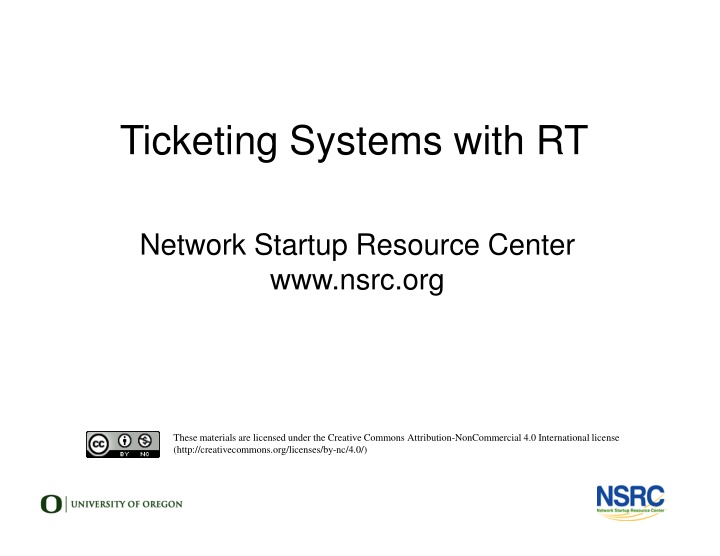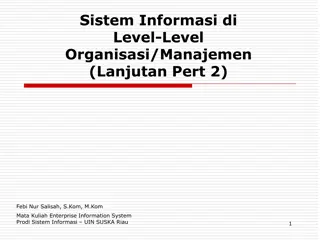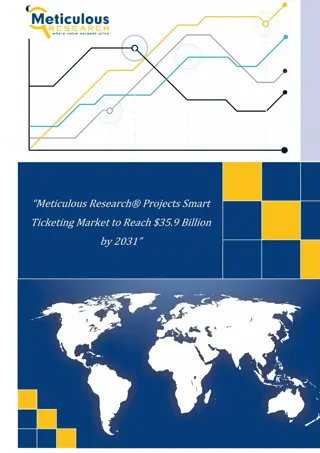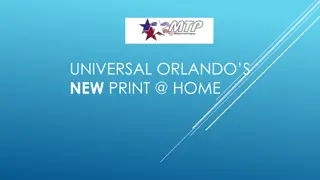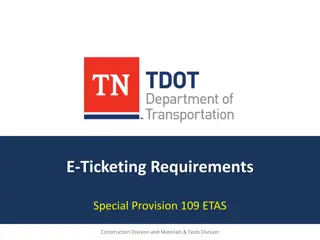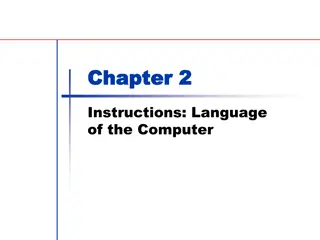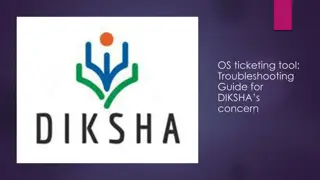Enhancing Support Operations with Ticketing Systems
Streamline support processes, track communication, and manage issues effectively with ticketing systems. Avoid forgotten problems and ensure efficient follow-up on customer requests. Explore different ticketing solutions like Trac, OTRS, and OsTicket for customized support management.
Uploaded on Mar 06, 2025 | 0 Views
Download Presentation

Please find below an Image/Link to download the presentation.
The content on the website is provided AS IS for your information and personal use only. It may not be sold, licensed, or shared on other websites without obtaining consent from the author.If you encounter any issues during the download, it is possible that the publisher has removed the file from their server.
You are allowed to download the files provided on this website for personal or commercial use, subject to the condition that they are used lawfully. All files are the property of their respective owners.
The content on the website is provided AS IS for your information and personal use only. It may not be sold, licensed, or shared on other websites without obtaining consent from the author.
E N D
Presentation Transcript
Ticketing Systems with RT Network Startup Resource Center www.nsrc.org These materials are licensed under the Creative Commons Attribution-NonCommercial 4.0 International license (http://creativecommons.org/licenses/by-nc/4.0/)
Typical Support Scenario Lots of email traffic requesting help, request for services, etc Archived as text without classification Very difficult to find current status or problem history Sometimes problems were forgotten or never resolved Difficult for another person to follow up on a problem that someone else started dealing with
Ticketing Systems Why are they important? Track all events, failures and issues Focal point for help desk communication Use it to track all communications Both internal and external Events originating from the outside: customer complaints Events originating from the inside: System outages (direct or indirect) Planned maintenance, upgrades, etc.
Ticketing Systems (Contd.) Use a ticket system to follow cases, including communication between the support staff Each case is considered a ticket Each ticket has a ticket number Each ticket goes through a similar life cycle: New Open Resolved
Request Tracker / Trac RT Heavily used worldwide Can be customized to your location Somewhat difficult to install and configure Handles large-scale operations A hybrid including wiki & project management features Web-only ticket system works well but not robust as RT Often used for trac king group projects. Used for this course: http://noc.ws.nsrc.org/wiki/
A Few Others Bugzilla: Cerberus: Eticket: Itracker: Jutda Helpdesk: Mystic: http://www.hulihanapplications.com/projects/mystic OTRS http://otrs.org/ OsTicket: http://osticket.com/ Simple Ticket: http://www.simpleticket.net/ Trouble Ticket Express: http://www.troubleticketexpress.com/ http://www.bugzilla.org/ http://www.cerberusweb.com/ http://www.eticketsupport.com/ http://www.itracker.org/ http://www.jutdahelpdesk.com/
RT: Request Tracker http://bestpractical.com/rt/
Essential Functionality Several interfaces Web, CLI, e-mail, etc. Multiuser At different levels: admin, general user, guest Authentication and authorization Event history Handles dependencies Notifications
RT: Advantages Open source and free Heavily used and tested Very active development Flexible Web interface or control via email Backend database (MySQL, Postgresql, Oracle, SQLite)
RT: Disadvantages A bit tricky to install the first time... Most distributions have packages that make installation a bit easier: Red Hat, Fedora, SuSE, Debian, Ubuntu, FreeBSD, etc. It's powerful, so you'll need to spend some time learning how it works Support for tracking service level agreements (SLAs) is basic
Users Anyone who interacts with RT is a user root Administrator with full privileges Privileged user (staff) Staff who are able to operate on tickets Has a password and can log in to the system Less powerful than root Normal user (guest) may only be able to see the status of his/her tickets May or may not be able log into the system Nobody default owner of new tickets
Groups Different users have different privilege levels Assigning privileges to each user would be time consuming Easier approach: create groups of users, and assign privileges to groups Groups useful for other purposes as well
People (Watchers, Actors) Each ticket has a set of people associated with it Requestor: who requested support Usually a customer (network user) But for internal tasks, requestor can be a member of the support team Owner: member of the support team who is responsible for the ticket at present Owner of a ticket can change over its lifetime Privileged users can take / assign ownership
People (Watchers, Actors) ctd. cc : who gets copies of all communications between staff and requestor (responses) Will see the communications, but may not be privileged to perform actions on tickets e.g. : the requestors boss admincc: who gets copies of responses as well as internal communications between staff while working on a ticket (comments) e.g. : manager of the support team
Updates / Transactions When a ticket is being worked on, there will updates or transactions (usually via email) Communications between requestor and RT (staff) are called replies Sometimes staff need to talk internally while working on a ticket These are called comments Requestors don t get copies of these
Ticket States New: The ticket has been received by RT, but not acted upon in any way RT notifies (via email) someone* of new tickets Open: Ticket is being acted upon Stalled: Progress on the ticket is stalled for some reason It will hopefully come back to open state Resolved: Problem has been solved No further action necessary
Ticket States ctd. Rejected: The ticket is not our problem. But records about the ticket stays in the RT database Deleted: The ticket does not belong on the system However, records about the ticket stay in the system If you want to completely get rid of a ticket, you can shred it Removes all database entries related to it
Queues Queues are a way to classify the tickets based on the nature of the request based on the actions required .
Problem Classification: Queues Services: DNS, IP addresses, Radius, LDAP Security: Attacks, scans, abuse, etc. Sytems: Email accounts, passwords, etc. Networking: Network Services Group Help Desk: Those who deal with end-users
Components Register an event (i.e., ticket creation) Assign an owner Assign interested parties (watchers) Maintain change history Inform interested parties of each change Initiate activities based on status or priority
Scrips (actions) Create automatic actions for queues scrips are snippets of Perl code Help automate things inside RT Take action X when condition Y occurs when a staff member responds to a ticket owned by nobody, make her the owner of ticket page everyone when the priority of a ticket becomes level X
Scrips (actions) ctd. Chapter 6 of O Reilly RT Essentials book Details on how to use Scrips: http://requesttracker.wikia.com/wiki/Scrip
RT Configuration Two Options Virtualhost: Subdirectory: Root user ('root') Change the default password on first login ('password') Assign the complete email for the root account: root@host.fqdn Assign all user rights: http://rt.host.fqdn http://host.fqdn/rt/ Global -> User Rights
User Creation Create a userid for each member of your team Assign privileges to each user
Create Groups Create groups of users: Administering privileges by group is more efficient than doing so for each user.
Create Queues Create queues for problem categories. For example Security Accounts Connectivity Assign users to groups and groups to each queue Different between AdminCC and CC Don't forget to create email aliases for each queue
rt-mailgate rt-mailgate facility lets us: Define virtual users on the RT server that correspond to ticket queues in RT. Allow third-party software (Nagios, Cacti, Smokeping, etc.) to automatically generate tickets in specified queues via email. Provide a simple interface through which end- users can communicate with your support organization via RT. More details at https://www.bestpractical.com/docs/rt/4.0/rt-mailgate.html
Extensions Extend the functionality of RT. For example: Send daily emails to remind users of tickets that have not been taken Send daily emails to each user reminding them of their pending tickets. Periodically increment ticket priority You can execute commands via email
References Best Practical Web site http://bestpractical.com/rt RT Essentials. Dave Rolsky et al. O'Reilly Media, Inc. Contributions to RT: http://requesttracker.wikia.com/wiki/Contributions Extensions http://requesttracker.wikia.com/wiki/Extensions http://bestpractical.com/rt/extensions.html Scrips http://requesttracker.wikia.com/wiki/Scrip http://requesttracker.wikia.com/wiki/ScripAction
